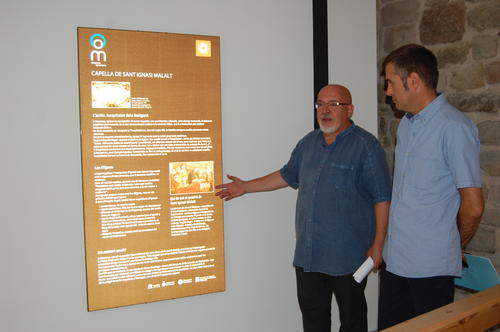Manresa releases new touristic signposting about Saint Ignatius' experiences and places. · 27/07/2015
Manresa releases new touristic signposting about Saint Ignatius’ experiences and places.

The signposting is based on a study released recently under the title of ‘Stories about the Ignatian city of Manresa. Proposals: basic for guidebooks, leaflets and digital formats’. In the first stage, the signposts for vehicles and pedestrians have been placed, as well as some identifying plaques. Totems and boards will be set in the second step, in autumn.
Manresa presents two interventions within the master plan of Manresa 2022. One of them consists of placing the touristic signposts to highlight the Ignatian cultural heritage; the other one is about the study on which it is based.
Both interventions have been presented today by the Cultural and Tourism councillor Joan Calmet and the ‘Catemocions’ consultor Josep Huguet (the study producer enterprise).
Joan Calmet has underlined that ‘the new signposts will indicate to visitors where car parks and interesting places can be found’. He has emphasised that ‘for the first time, the term of Historic Centre will be used. Furthermore, plaques will incorporate a QR code and other symbols evincing if the building is included in the Ignatian trail and whether it is medieval or baroque heritage.
Furthermore, Josep Huguet has explained on what the study created by Catemocions consists: ‘it is similar to a bible since it acts like an umbrella containing a significant part of Manresa’s history (from the year 1300 up to 1500) with Saint Ignatius character as unifying thread’. ‘The pilgrim moves around the city, and through his steps, one can discover the different aspects about the function of the medieval hospitals, the crosses set on the boundaries, the role of the Cistercians, etc.’
During this last week of July, the first stage to place new touristic boards has started, subsidised entirely by the Barcelona’s Council spending about 60.000€, with the aim of standing out Saint Ignatius’ vital trail in Manresa and make people aware of the social and historical context of that time, as well as improving the information about the signalled buildings.
Part of the boards are plaques with an outline about the site and Saint Ignatius’ experiences according to witnesses. There will also be some totems giving specific information about the building so that the visitor can compose the whole puzzle by only taking the route.
Intervention: 1st stage
108 signposts for vehicles have been set in the city to guide visitors towards the Historical Centre and car parks.
17 plaques of 35x35cm inform about the cultural heritage. 13 of them have been placed on façades, whereas 4 boards lay on a kind of lectern.
These places are:
Santa Clara’s convent, Carme’s convent, Marcetes’ country house (Viladordis), Sant Pau’s chapel and water tank, Can Canyelles, Amigant’s house, Santa Caterina’s tower, Sant Marc’s church, Guia’s Chapel, Sant Bartomeu’s chapel (Casal de les Escodines), Guia’s cross, Beuys’ cross, Culla’s cross and Pou de la Llum (well of light)
3 boards of 80x150cm are inside two Ignatian places nowadays used to welcome visitors and pilgrims: Museu Comarcal de Manresa (regional museum of Manresa) and Casal de les Escodines (Escodines country house) which is the old Sant Bartomeu’s convent.
Two other boards can be found inside the Chapel of Sick Saint Ignatius and in the Basilica of La Seu’s church (next to the statue of this character, recently presented).
Intervention: 2nd stage
This second signposting will start in September and is going to include:
3 boards inside important buildings.
6 totems in neuralgic sites (4 of them will be new, while 2 will be replaced)
2 panoramic lecterns situated near Santa Catarina’s tower and the Balconada’s viewpoint, where Pou de la Llum’s sculpture (well of light) are located.
Besides, 85 new indicators that will guide pedestrians through the Historical Centre, so that they can find and discover the Ignatian heritage easily. The new boards will be brown and will display the logo of the Ignatian Way to identify them.
This project is part of the global touristic signposting in Manresa already started in 2009 to acquire coherence, visibility, utility and modernity.
Stories about the Ignatian city of Manresa
The information displayed on the different boards has been taken from the 204-page study carried out by Catemocions on Saint Ignatius: his history, his origins, a description about the Manresa city he found in 1522, the context in Europe and the people he met. This investigation describes the 22 Ignatian places and their texts are included in the plaques, boards, totems, guidebooks and audio guides.

